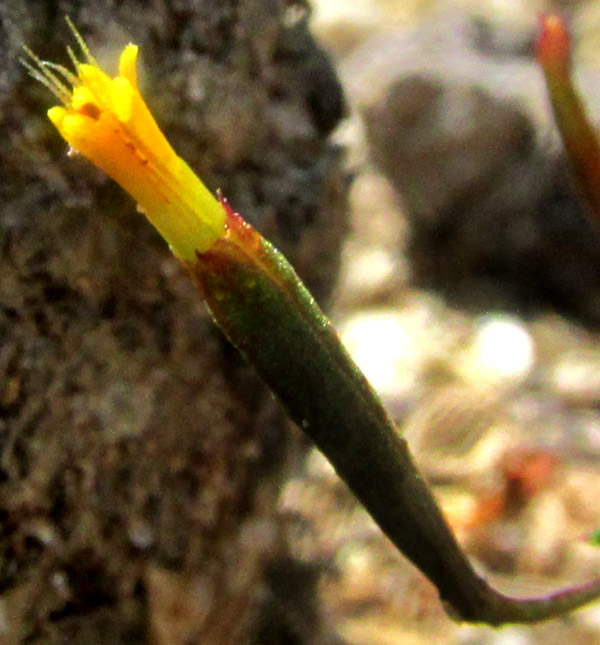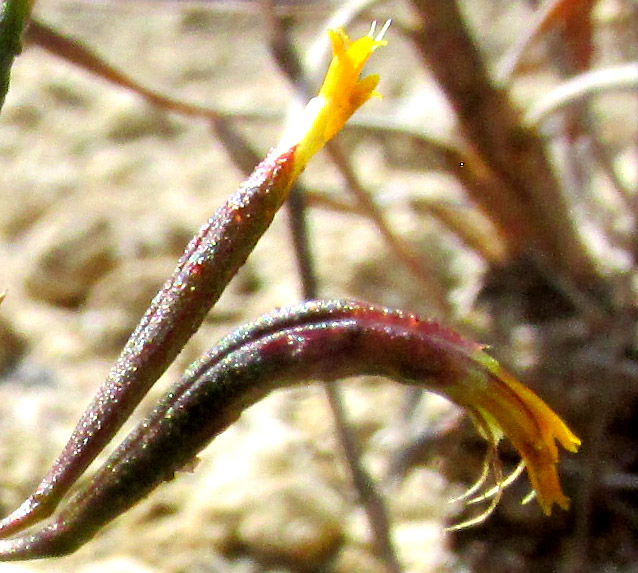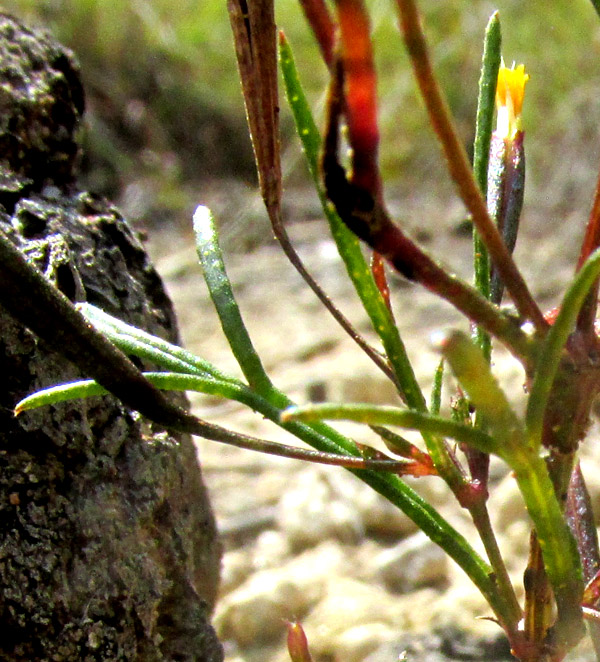Excerpts from Jim Conrad's
Naturalist Newsletter
Entry dated November 10, 2023, from notes taken on ridge with secondary oak forest about 300m west of Cascadas de La Piedad waterfall 3kms NW of the community of San Pablo, municipality of Almeaco de Bonfil; N20.1002°, W100.0067°, elevation 2360 meters (7750ft); extreme southern Querétaro state, MÉXICO
A STUNTED TAGETES MICRANTHA

In an abandoned field eroded down to hard compacted tuff, or volcanic ash, and strewn with rhyolite and pumice rocks, the above was the only flowering plant surviving the harsh conditions. It was a dry, exposed, hot environment with almost no soil. Apparently the wildflower survived in shade afforded by the rock, and on a tiny amount of soil washed from a nearby grassy area to around the rock's base. The survival was even more surprising because of the ongoing, two-year long period the North American Drought Monitor categorizes as a D3 Severe Drought.

Up close, the flower structure was confusing, until the pale bristles were noticed overtopping the yellow corollas. Such bristles are seen on certain members of the enormous Composite/Aster/Sunflower Family, the Asteraceae. In that light it was understood that, as shown above, cylindrical corollas of disc florets were emerging from a slender, bowl-like, green involucre composed of four or five scale-like phyllaries. The phyllaries appeared to be fused with one another along most of their margins. No ray florets with flat corollas arising along the periphery of the cluster of disc corollas were present.

Other flowering heads contained fewer florets, and one was curved for no obvious reason. The important field mark to notice above is that the phyllaries were densely covered with tiny, glistening glands. Such glands and the florets' yellow color suggested the traditional Marigold tribe of the Aster Family. Genera in that tribe occur worldwide, but their center of diversity is here in the Mexican highlands, where interesting species can turn up.

The above fruiting head bore five or six slender, one-seeded, cypsela-type fruits, each of which was topped by a mixture of scales which were either flat and irregularly blunt or needle-like.

Above, note the single, deeply once-lobed, crowfoot-shaped leaf arising from the stem at the picture's lower, right, and extending diagonally toward the rock's top. The leaf also bears many glands, and the blade's margins are not toothed.
This plant was tricky to identify because apparently it is much stunted by its harsh environmental conditions. In richer, moister soil, later I was to learn, the plant grows up to 50cm tall (20inches). Also, most individuals' flowering heads develop up to five flat, petal-like ray florets along the sides -- though sometimes none -- and leaves nearly always develop more than one pair of side lobes. On robust plants, even the side lobes develop their own slender lobes. An important adaptive feature of this species definitely is that it can alter its general form dramatically, depending on its environment. It's impressive that this little plant with so few, much-reduced leaves produced so many healthy-looking fruits .
Though our plant's size and general form greatly differ from most individuals of the species, the basic structure of its flowers, fruits and vegetative parts remains the same. Analyzing this basic structure leads to the surprising realization that here we're dealing with yet another marigold species, a real one, of the marigold genus Tagetes.
In this highland, central Mexican region, we have perhaps eight marigold species. Of those eight, if your marigold's leaves are once-divided, the florets are yellowish, and the leaves' margins bear no teeth, you have TAGETES MICRANTHA, with no English name.
Tagetes micrantha occurs in various upland disturbed habitats and forests from the dry uplands of the US southwestern states south through out Mex in spottily occurring parts of the Mexican uplands. The species is described as having very aromatic herbage, a trait I didn't notice, not wanting to crush the few leaves. Pictures on the Internet often show Tagetes micrantha with at least one white, petal-like ray flower corolla. Probably our plant was too stressed to produce them.
In Mexico, various local names, such as anicillo, anís, anís del campo, anisito, anisito rojo, hierba anís, hinojo, pericón, pericón anís reflect the plant's anis odor. As such, it's not surprising that the online Atlas de las Plantas de la Medicina Tradicional Mexicana website reports numerous uses, especially with regard to upset stomach, as well as headaches, and in healing ceremonies for susto, a general dread or fear of things, for which having a nice-smelling herb shaken all over you might bring relief.